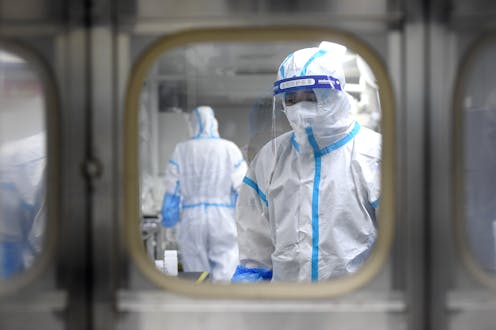Source: The Conversation (Au and NZ) – By Simone Celine Marshall, Professor of Medieval Literature, University of Otago

Getty Images
The COVID “lab leak” story clearly isn’t going away soon. The theory that the pandemic began with an accidental release of the virus from a lab in Wuhan recurs like clockwork – most recently in a report from Senate Republicans in the US this week.
Earlier this year, the US Department of Energy and FBI endorsed the same theory. It’s a very modern story – but as medievalists, we can tell you we’ve been here before, and we should be wary of simple narratives of blame.
The lab leak theory remains a legitimate hypothesis to investigate. Yet much of the discussion surrounding it shows evidence of the “contagion effect” of magical thinking – the belief that a visible effect is somehow contaminated by a hidden essence linked to its origin.
The anxieties still whirling in conservative media echo the escalating accusations of well-poisoning in medieval Europe. These exploded into mass violence in the mid-14th century, and survive in later legends about witches’ ability to concoct poisonous agents.
In an age of antibiotics and scientific explanations, we like to consider ourselves more advanced than our forebears. But our research into the early history of conspiracy theories and xenophobia tells a more complicated story about how magical thinking continues to shape our response to disasters like the pandemic.
Poisonous powders and plagues
Fears of contagion often derive from anxieties about unknown or poorly understood aspects of disease. Who among us never felt compelled to disinfect our groceries or mail during the early months of the pandemic?
Our current research, “The First Era of Fake News: Witch-Hunting, Antisemitism and Islamophobia”, examines how myths that emerged during the Middle Ages are still being used to justify modern atrocities. It shows how the contagion effect also leads to scapegoating and faulty attributions of blame. The threat of disease is layered onto suspicious “others” – such as Jews during the Middle Ages, or Chinese labs today.
When Jews were accused of poisoning wells to cause outbreaks of plague in 1348-49, the “contagion” associated with them was both literal and metaphorical. Jews were accused of concocting poisonous powders from spiders, toads and human remains – the ingredients form a running list of items invoking disgust and fear of infection.
Read more:
COVID-19: why lab-leak theory is back despite little new evidence
But Jews were also considered suspicious simply because they were Jews – exotic religious outsiders who might have connections with coreligionists in other cities, or who might travel far from home. Jews were feared to contaminate Christian communities by their very presence, and medieval preachers weren’t shy about saying so.
We can call this kind of contagion “magical” – fear that simple contact with a mistrusted outsider somehow makes us vulnerable to influences or activities we do not understand. We should take heed: in the case of well-poisoning accusations, those fears led to the wholesale slaughter of Jewish communities in Central Europe.
Individual Jews were tortured into elaborate confessions of guilt, then murdered along with their communities. They were blamed for the plague’s spread and devastation. The contagion effect easily convinced medieval Christians that a terrible disease must originate with people already considered suspicious.

Getty Images
Conspiracy and Christianity
There are similar fears of magical contagion in theories about the lab leak being the pandemic’s origin. Blame is a powerful motivator. We continue to be swayed by the idea that some specific agency must be responsible, rather than unpredictable processes of virus mutation.
Even China has embraced this logic, with various suggestions made about the virus emerging somewhere (anywhere) outside its borders. The contagion effect has also been manipulated for political advantage. Donald Trump’s early fear mongering about a “China virus” was a convenient distraction from the failures of his own administration in the early days of the pandemic.
Like medieval civic leaders, it was easier for some politicians to assuage the rage and anxiety of people with stories of blame than by acknowledging failures and unknowns.
There are bad as well as good reasons to investigate the lab-leak hypothesis. Using the theory as a way to target and punish enemies is a bad reason. So is the a priori assumption that nefarious intentions lie somewhere behind every major event, a cornerstone of conspiratorial thinking both ancient and modern.
We should be on the alert for this style of thinking. It tends to get people killed. When Jews were accused of poisoning wells in medieval Europe, they were believed by many to be doing so “in order to destroy and eradicate the whole Christian religion”.
Viral magical thinking
In some political quarters, the lab-leak theory operates as the thin edge of a similar civilisational struggle, with the Chinese as the villains working in secret on various schemes to dominate or destroy Western democracies.
Such accusations attempt to impose coherence on a profoundly uncertain situation, and suggest a reassuring narrative of clear cause and effect rather than random chance.
Read more:
From UFOs to COVID conspiracy theories, we all struggle with the ‘truth out there’
China’s tight-lipped approach to information-sharing isn’t helping to allay suspicions. In the eyes of lab-leak theory advocates, the desire to hide information suggests something more nefarious than a simple desire to avoid blame.
But embracing an argument built on a tissue of circumstantial evidence is also part of the conspiracy theory playbook: magical thinking enters the grey zone of unanswered questions to create elaborate narratives of false reassurance.
Some questions about the origin of COVID-19 may never be answered. For many, that is an unpalatable idea. Yet if we are to intervene in this historical pattern of overreaction, conspiracy theory and blame, we need to be honest about the limits of our knowledge.
![]()
Simone Celine Marshall and Hannah Johnson have received Fulbright funding for their project, “The First Era of Fake News: Witch-Hunting, Antisemitism and Islamophobia”.
Work on this project is being supported by a Fulbright fellowship. Neither Fulbright International nor Fulbright NZ pays fellowship recipients for publication. The authors’ opinions are entirely their own, and do not represent the views of any organisation.
– ref. Plagues, poisons and magical thinking – how COVID lab leak hysteria could be straight from the Middle Ages – https://theconversation.com/plagues-poisons-and-magical-thinking-how-covid-lab-leak-hysteria-could-be-straight-from-the-middle-ages-204025







